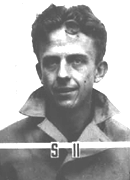David Hawkins (philosopher)
| David Hawkins | |
|---|---|

David Hawkins' Los Alamos ID badge
|
|
| Born |
February 28, 1913 El Paso, Texas |
| Died | February 24, 2002 (aged 88) Boulder, Colorado |
| Nationality | American |
| Known for | Hawkins–Simon theorem |
| Academic background | |
| Alma mater |
Stanford University University of California, Berkeley |
| Thesis title | A Causal Interpretation of Probability |
| Academic work | |
| Institutions |
Washington University University of Colorado |
David Hawkins (February 28, 1913 – February 24, 2002) was a professor whose interests included the philosophy of science, mathematics, economics, childhood science education, and ethics. He also served as an administrative assistant at Manhattan Project's Los Alamos Laboratory, and later as one of its official historians. Together with Herbert A. Simon, he discovered and proved the Hawkins–Simon theorem.
David Hawkins was born in El Paso, Texas, the youngest of seven children of William Ashton Hawkins, and his wife Clara née Gardiner. His father was a prominent lawyer noted for his work on water law, who worked for the El Paso and Northeastern Railway, and was one of the founders of the city of Alamogordo, New Mexico. He grew up in La Luz, New Mexico.
Hawkins attended Hotchkiss School in Lakeville, Connecticut, but left after his junior year to enter Stanford University. He initially studied chemistry, but then switched to physics before finally majoring in philosophy. He was awarded his B.A. in 1934 and M.A. in 1936. While he was there, he met Frances Pockman, a teacher and writer. They were married in San Francisco in 1937. They had a daughter, Julie.
In 1936 Hawkins went to the University of California, Berkeley, to work on his doctorate. He became friends with Robert Oppenheimer, with whom he liked to discuss Hindu philosophy, and issues in the philosophy of science, such as the uncertainty principle, and Niels Bohr's complementarity. In 1938, Hawkins and his wife Frances joined the Berkeley campus branch of the Communist Party of America. He earned his Ph.D. in 1940, writing his thesis on "A Causal Interpretation of Probability".
...
Wikipedia
